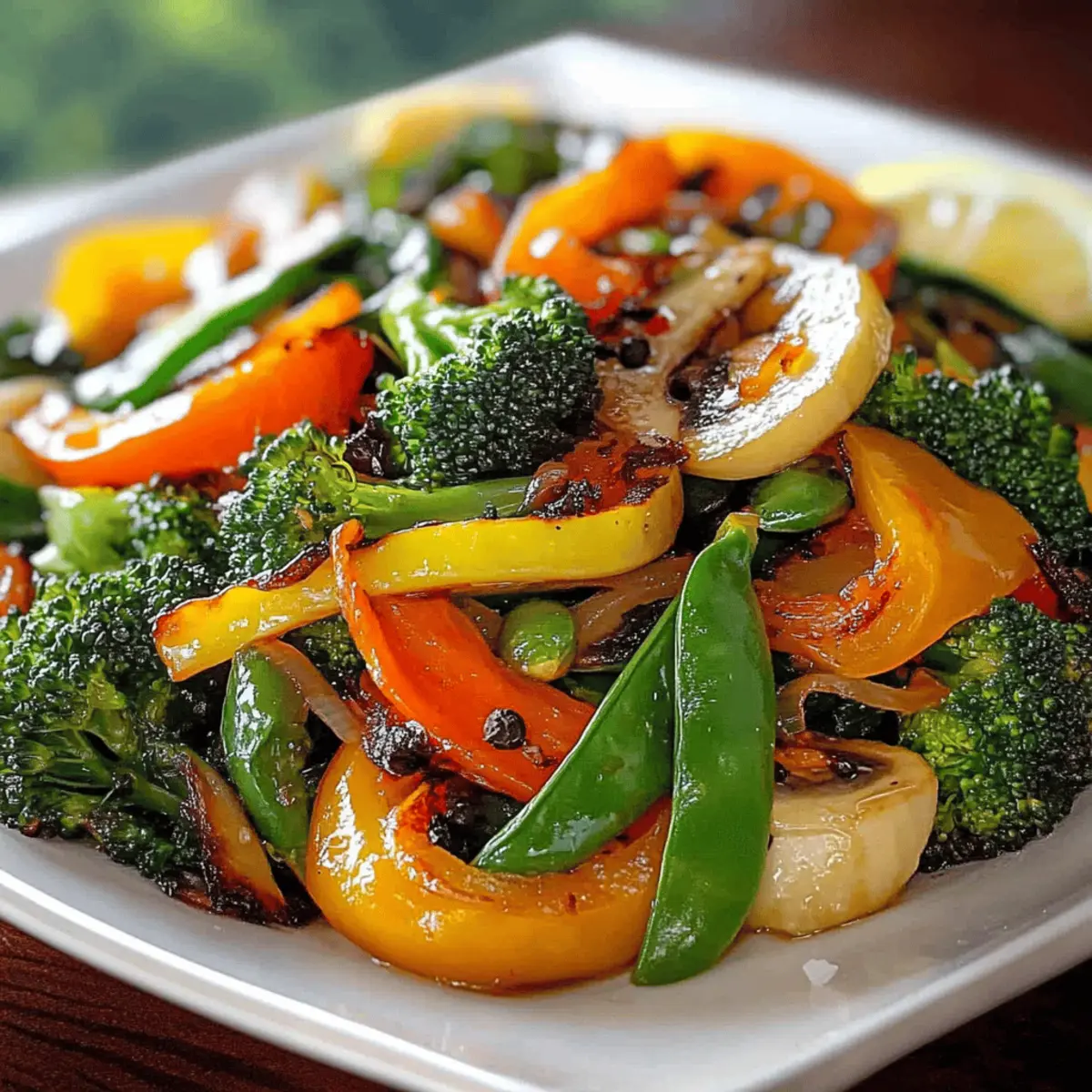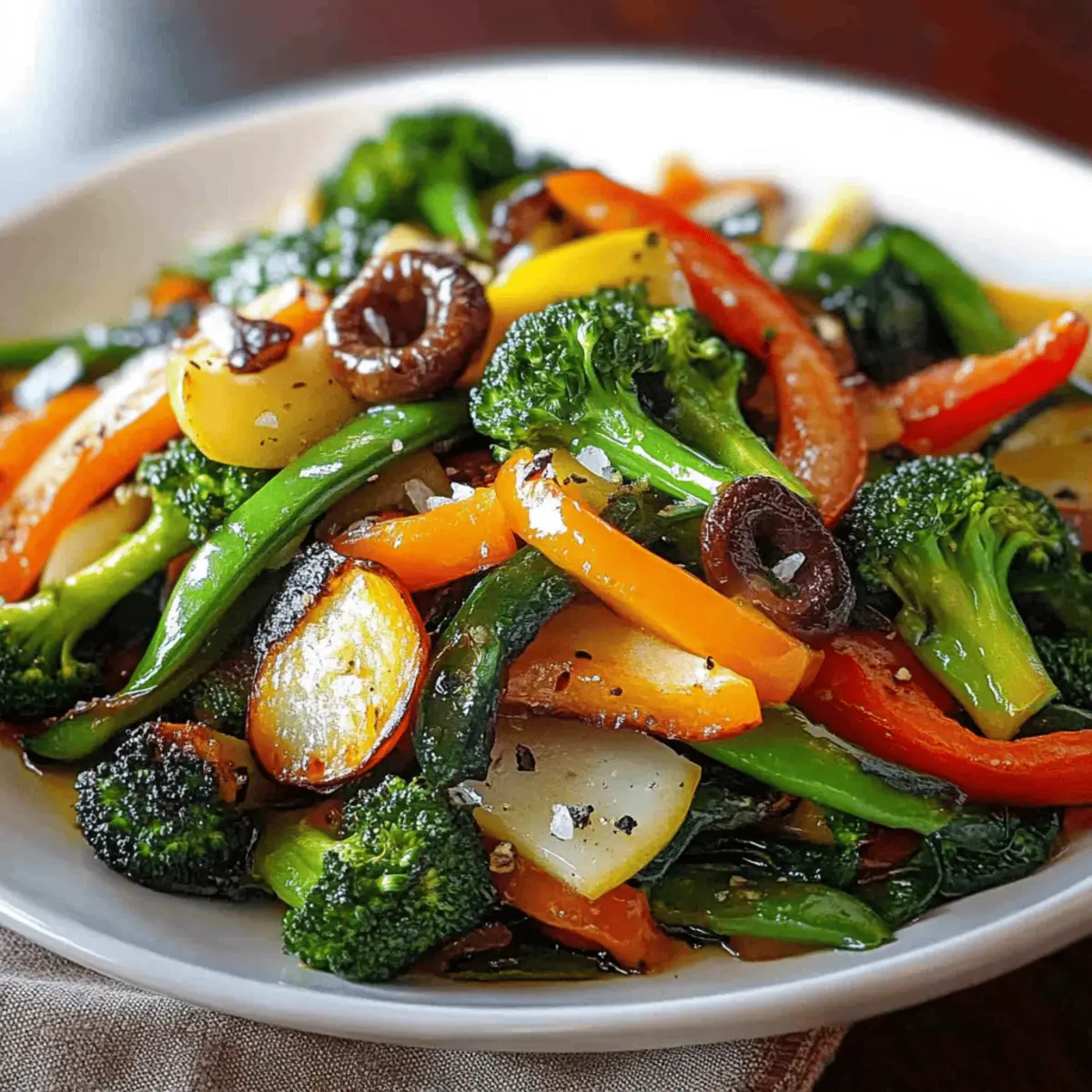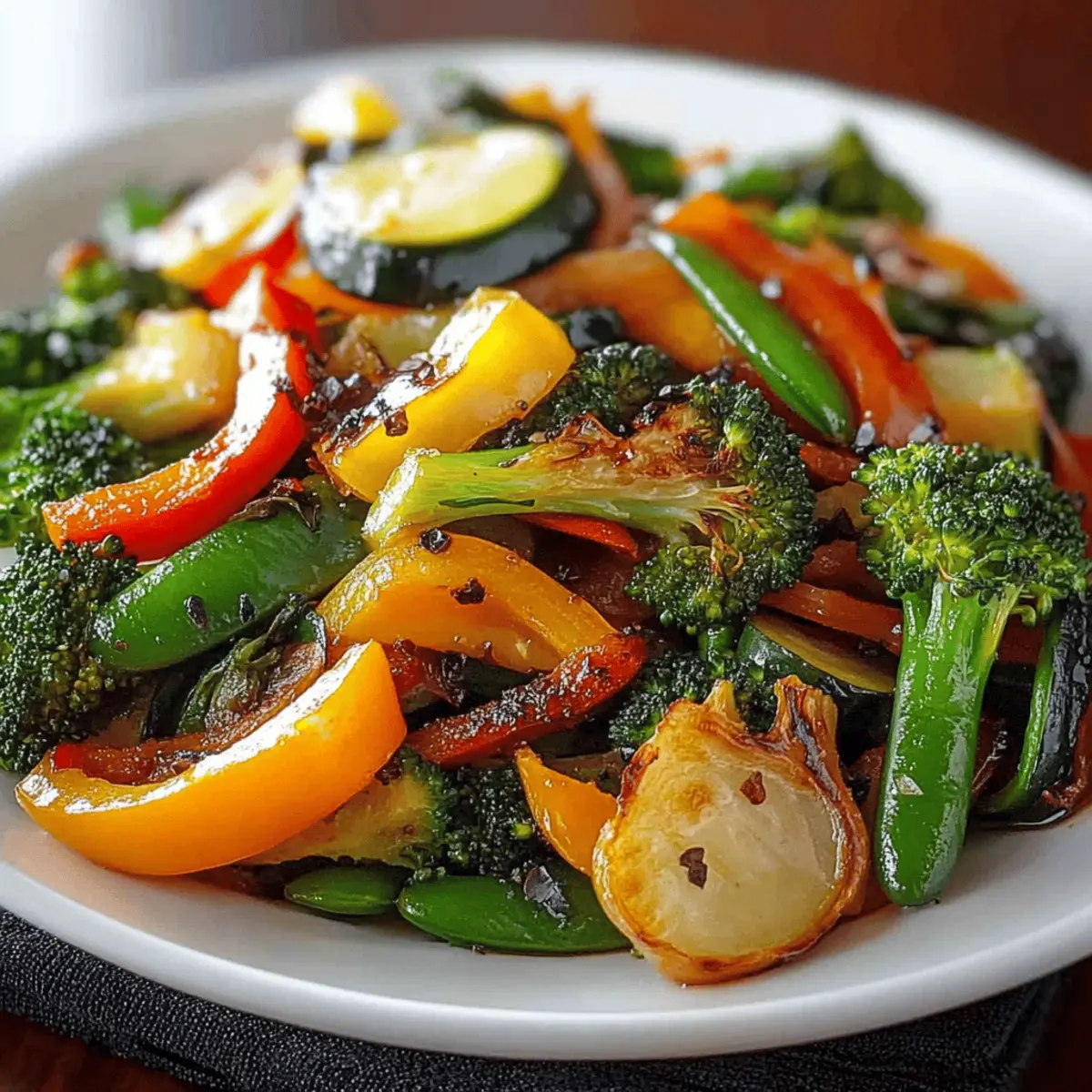As I stood over the stove, the vibrant colors of my fresh produce caught my eye, promising something special. This recipe for Healthy Sautéed Vegetables is the perfect way to transform a medley of crisp veggies into a nutrient-packed delight that will elevate your meals. Not only is this dish a quick prep marvel, making weeknight dinners a breeze, but it’s also an incredibly versatile side that can be transformed into endless cuisines—from zesty Mediterranean to bold Asian-fusion. Whether you’re meal prepping for the busy days ahead or simply looking to add some nutritious flair to your plate, these sautéed vegetables have got you covered. So, let’s dive into the colorful world of veggie magic—what flavors are you eager to explore today?

Why Are Sautéed Vegetables So Amazing?
Nutritious Boost: This recipe maximizes the health benefits of fresh produce, ensuring you get your daily dose of vitamins and minerals.
Quick Preparation: With minimal cooking time, you can whip this dish up in under 15 minutes, making it a lifesaver for busy nights!
Endless Flavor Options: Feeling adventurous? Swap in your favorite herbs and spices to create diverse flavors, from a simple garlic infusion to a spicy Asian twist.
Crowd-Pleaser: Whether hosting friends or looking for a healthy side for your family, these sautéed veggies are sure to impress and satisfy everyone.
Meal Prep Magic: Perfect for meal prep, these vegetables can be cooked in advance and reheated, keeping weeknight dinners quick and stress-free!
And if you’re looking for more fantastic side dishes, don’t forget to check out my Chicken Vegetables Skillet or the delightful Healthy Creamytuscan Salmon for well-rounded meal inspirations!
Healthy Sautéed Vegetables Ingredients
For the Base
- Olive Oil – Essential for enhancing flavor and perfect for sautéing; substitute with avocado oil for a different flair.
- Garlic (2 cloves, minced) – Adds aromatic depth; shallots or garlic powder can be used in a pinch.
- Onion (1 small, thinly sliced) – Brings sweetness and complexity; shallots offer a milder alternative.
For the Vegetables
- Bell Pepper (1, sliced) – Infuses vibrant color and crunch; any sweet pepper variety works well as a substitute.
- Zucchini (1, sliced into half-moons) – Contributes a soft texture that absorbs flavors beautifully; yellow squash is a great swap.
- Broccoli (1 cup, florets) – Provides nutritional benefits and a slight crunch; cauliflower can be used for a different texture.
- Carrot (1 medium, julienned or thinly sliced) – Naturally sweetens the dish; parsnips bring a unique twist.
- Snap Peas (½ cup) – Offers crispness and a fresh bite; snow peas provide a similar crunch.
- Mushrooms (½ cup, sliced) – Brings umami richness and substance; feel free to choose your favorite mushroom variety.
For Seasoning
- Salt & Black Pepper – Fundamental for flavor enhancement; adjust to your preference.
- Lemon Juice (1 tsp, optional) – Brightens the overall flavor; lime juice can add a nice zesty kick.
- Balsamic Vinegar or Soy Sauce (1 tsp, optional) – Introduces acidity or saltiness; rice vinegar offers a lighter option.
For Enhancements
- Optional Toppings – Toasted nuts, seeds, fresh herbs, or grated Parmesan can elevate the dish’s texture and flavor profile.
These ingredients for Healthy Sautéed Vegetables create endless possibilities to delight your taste buds while nurturing your body!
Step‑by‑Step Instructions for Healthy Sautéed Vegetables
Step 1: Prep Vegetables
Begin by washing all your vegetables under cold water. Carefully cut the bell pepper, zucchini, and onion into uniform slices to ensure even cooking. Julienning or thinly slicing the carrot and mushrooms promotes a nice, delicate texture. Place all the prepared vegetables in separate bowls, ready to be sautéed to create your Healthy Sautéed Vegetables.
Step 2: Heat Oil
In a large skillet, pour in 1-2 tablespoons of olive oil and heat it over medium-high heat. Allow the oil to shimmer, which indicates it’s ready for sautéing. This should take about 1-2 minutes. The right temperature will ensure that the vegetables cook quickly while retaining their crispness and vibrant colors.
Step 3: Cook Aromatics
Add the minced garlic and sliced onion into the hot oil. Sauté for 1-2 minutes until the onions become translucent and fragrant, stirring frequently to avoid burning. The aroma will fill your kitchen, setting the perfect base for your Healthy Sautéed Vegetables.
Step 4: Add Harder Vegetables
Now, it’s time to add the carrots and broccoli to the skillet. Stir well and cook for 3-4 minutes, keeping a close eye on them and stirring often. This step will soften the harder vegetables while you prepare to introduce the softer ones next.
Step 5: Add Softer Vegetables
Introduce the bell pepper, zucchini, mushrooms, and snap peas into the skillet. Sauté this colorful medley for an additional 4-5 minutes until all the vegetables are crisp-tender. You’ll notice their vibrant colors shining through, creating a beautiful and appetizing sight.
Step 6: Season
Sprinkle in salt and black pepper to taste, and if desired, add lemon juice, balsamic vinegar, or soy sauce for an extra flavor boost. Stir everything once more to evenly distribute the seasoning among your Healthy Sautéed Vegetables, enhancing their natural flavors with a zing.
Step 7: Finish & Serve
Once the vegetables are perfectly sautéed and melded together, remove the skillet from the heat. Transfer the dish to your serving platter and garnish with optional toppings like toasted nuts, seeds, or fresh herbs. Serve immediately to ensure the delightful textures and aromas are fully enjoyed!

How to Store and Freeze Healthy Sautéed Vegetables
Fridge: Store leftovers in an airtight container for up to 3-4 days to maintain freshness. Be sure to let them cool completely before sealing to avoid condensation.
Freezer: For long-term storage, freeze cooked vegetables that are slightly undercooked for optimal texture. Use freezer-safe bags or containers, and label with the date for easy reference. They can last up to 3 months.
Reheating: Reheat in a skillet over medium heat for a few minutes until warmed through, maintaining the vibrant flavors and textures of your Healthy Sautéed Vegetables.
Room Temperature: Avoid leaving cooked vegetables at room temperature for more than 2 hours to prevent spoilage. Always store leftovers promptly!
What to Serve With Healthy Sautéed Vegetables
Let your imagination run wild as you create a meal that bursts with color, flavor, and nutrition.
-
Fluffy Quinoa: The nutty flavor and fluffy texture of quinoa pairs beautifully with sautéed vegetables, creating a satisfying and balanced dish.
-
Garlic Butter Rice: A side of garlic butter rice adds richness and complements the fresh, crisp veggies while soaking up their savory juices.
-
Grilled Chicken Breast: Tender, juicy grilled chicken provides a protein-packed addition that rounds out the meal and enhances the flavor experience.
-
Crispy Tofu: For a plant-based option, serve crispy tofu as a savory counterpart, perfectly soaking in the delicious vegetable juices.
-
Mediterranean Couscous: Light and fluffy, couscous brings a hint of lemony brightness, making it a delightful partner for the vegetable medley.
-
Roasted Sweet Potatoes: The sweetness of roasted sweet potatoes contrasts beautifully with the sautéed vegetables, creating a harmony of taste and texture.
-
Fresh Spinach Salad: A light spinach salad with a zesty dressing balances the meal, adding extra vitamins and a refreshing touch.
-
Toasted Almonds: Sprinkle some toasted almonds for crunch and earthiness, elevating the sautéed vegetables with a delightful texture.
-
Sparkling Water with Lime: Refresh your palate with a sparkling water dressed with lime; it adds a touch of zing that perfectly complements vegetable flavors.
Expert Tips for Healthy Sautéed Vegetables
-
Uniform Cuts: Make sure to cut all vegetables into similar sizes to ensure even cooking. This prevents any pieces from becoming overcooked or undercooked.
-
Don’t Overcrowd: Avoid overcrowding the skillet! Cook in batches if necessary so that all vegetables have enough space to sauté properly without steaming.
-
Infuse Flavor: Always sauté the garlic and onion before adding the veggies. This allows the oil to absorb their flavors, enhancing the final dish’s taste.
-
Taste as You Go: Always taste your Healthy Sautéed Vegetables before serving. Adjust the seasoning with salt, pepper, or lemon juice to bring out the freshest flavors.
-
Meal Prep Friendly: Chop your vegetables ahead of time and store them in airtight containers. Sauté them just before serving to maintain crispness and flavor.
Make Ahead Options
These Healthy Sautéed Vegetables are a fantastic choice for meal prep, saving you precious cooking time on busy weeknights! You can chop and refrigerate the vegetables (up to 24 hours) in advance, which helps maintain their crispness and vibrant colors. Just be sure to store them in an airtight container to keep them fresh. When you’re ready to enjoy, simply heat your skillet, sauté the garlic and onions, add the prepped vegetables, and cook for about 8-10 minutes until they’re crisp-tender. Following these prep ahead instructions will ensure you have a delicious, quick side dish that’s just as delightful as when made fresh!
Healthy Sautéed Vegetables Variations
Invite creativity into your kitchen and explore these delightful twists on a classic recipe!
-
Vegan Delight: Swap out butter for coconut oil to keep the dish plant-based and add a subtle sweetness.
-
Mediterranean Twist: Toss in olives, sun-dried tomatoes, and feta cheese for a vibrant flavor profile that screams sunshine. Imagine a sunny Mediterranean day with every bite!
-
Spicy Kick: Incorporate chili flakes or fresh jalapeños for that extra heat, transforming your veggies into a fiery fiesta. Perfect for those who love a little spice in their life!
-
Asian Fusion: Add soy sauce and sesame oil with a sprinkle of sesame seeds to introduce a nutty hue that delights the senses. This twist will pair beautifully with any Asian-inspired main dish!
-
Herb-Infused: Experiment with various fresh herbs like thyme, basil, or cilantro for a fragrant garden appeal. Fresh herbs can elevate your sautéed veggies into a culinary masterpiece!
-
Roasted Garlic: Instead of fresh, consider roasted garlic for a sweeter, mellow flavor that mellows the dish beautifully. It’s like a cozy hug for your taste buds!
-
Nutty Crunch: Toss in some toasted almonds or walnuts at the end for a delightful crunch and added nutrition. This extra layer of texture will make your dish irresistible!
-
Zesty Lemon: Brighten up the flavors with a splash of lemon or lime juice, taking your sautéed veggies from good to unforgettable! Pair it with grains or protein for a wholesome meal.
Each of these variations offers a delicious opportunity to explore global flavors and make this side dish truly unique. And if you’re looking for more scrumptious side companion ideas, why not check out my Grilled Shrimp Bowl or the colorful Chicken Vegetables Skillet? Let’s keep that kitchen sizzling!

Healthy Sautéed Vegetables Recipe FAQs
How do I choose the best vegetables for sautéing?
Absolutely! When selecting vegetables, look for those that are firm, vibrant in color, and free from dark spots or blemishes. For example, bell peppers should be shiny with a taut skin, while zucchini should feel solid and have smooth, glossy skin. Freshness is key; avoid any floppy or wilted vegetables for the best texture and flavor in your Healthy Sautéed Vegetables.
How should I store leftover sautéed vegetables?
Store any leftovers in an airtight container in the refrigerator for up to 3-4 days. Ensure the vegetables have cooled completely before sealing the container to prevent condensation, which can lead to sogginess. When you’re ready to enjoy them again, just reheat quickly in a skillet for that freshly sautéed feel!
Can I freeze my sautéed vegetables?
Yes, you can definitely freeze your Healthy Sautéed Vegetables! For best results, I recommend slightly undercooking them before freezing to maintain texture. Let your sautéed veggies cool, then transfer them into freezer-safe bags or containers. Label them with the date—these will stay good in the freezer for up to 3 months. When you’re ready to use them, simply thaw and reheat in a skillet until they’re warmed through.
What if my sautéed vegetables turn out mushy?
If you find your sautéed vegetables are mushy, it might be due to overcrowding the pan or cooking them for too long. Always give the vegetables plenty of space in the skillet, as this allows them to sauté rather than steam. Next time, try cooking in smaller batches. For extra crispiness, make sure to keep an eye on the cooking time—aim for that beautiful crisp-tender texture!
Are there any dietary considerations I should keep in mind?
Definitely! This Healthy Sautéed Vegetables recipe is vegan and vegetarian-friendly, making it suitable for various diets. If you’re cooking for someone with allergies, take care with the optional toppings like nuts and cheese which could trigger reactions. For those watching salt intake, adjust the seasoning as needed, or consider using low-sodium soy sauce if you opt to include it. It’s a versatile dish that you can modify to fit different dietary needs!
Can I meal prep these sautéed vegetables?
Very much so! These sautéed vegetables are fantastic for meal prep. You can chop them in advance and store them in the fridge for up to 3 days. When meal prepping, it’s best to sauté the veggies just before serving to keep them fresh and maintain that lovely texture. This way, you’ll have a quick and healthy side ready for any meal throughout the week!

Savory Healthy Sautéed Vegetables to Brighten Your Plate
Ingredients
Equipment
Method
- Wash all vegetables under cold water, and cut the bell pepper, zucchini, and onion into uniform slices. Place the vegetables in separate bowls.
- In a large skillet, heat 1-2 tablespoons of olive oil over medium-high heat for about 1-2 minutes.
- Add minced garlic and sliced onion to the oil and sauté for 1-2 minutes until onions are translucent.
- Add carrots and broccoli to the skillet, stirring and cooking for 3-4 minutes.
- Introduce the bell pepper, zucchini, mushrooms, and snap peas, and sauté for an additional 4-5 minutes until crisp-tender.
- Season with salt, black pepper, lemon juice, balsamic vinegar, or soy sauce to taste, and stir to combine.
- Remove from heat, garnish with optional toppings, and serve immediately.

Leave a Reply